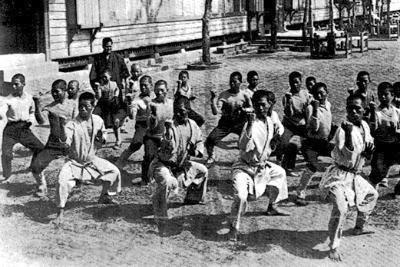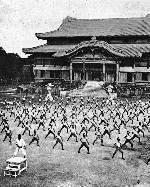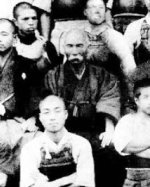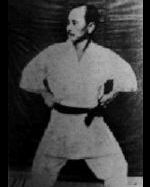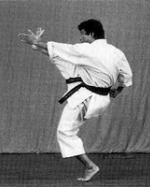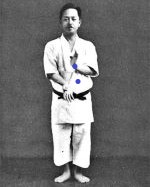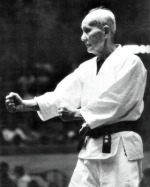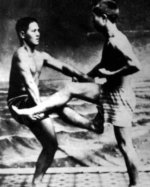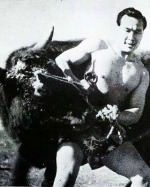The History of Karate
What is Karate?
Traditional karate is a self-defence system that combines fast, direct techniques with great power that is generated through body mechanics.
Talk the Talk
Karate literally means Empty (Kara) Hand (Te), referring to the fact that the art is largely built around unarmed combat.
Originally it was called Chinese
Hand but was changed by Gichin Funakoshi when he introduced the art to Japan.
Karate History Fact
Generally speaking, the aim of a karateka when forced to fight is to subdue an opponent with one decisive karate technique.
If that does not happen with the first strike,
then it is swiftly followed up by another move with the same intent and then another until an opponent is beaten or the combination naturally ends and a defensive guard is
re-established.
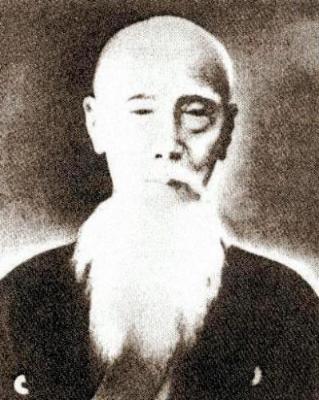
In its current form, karate history is less than two hundred years old but it does have roots that date back thousands of years.
Much of what developed prior to the nineteenth century came from the Shaolin style of kung fu, which can be traced back to around the fifth or sixth century when an Indian monk named Bodhidharma is said to have taught fighting techniques to the monks at the temple there.
Early Okinawan Karate
The origins of Karate on the island of Okinawa can be traced back to the late seventeenth century when a ban on weapons and martial arts was imposed by the Japanese ruling samurai clan, the Satsuma.
As a result, the exact evolution of karate history is lost due to the lack of information being written down. All training had to be done in secret and as weapons could not be carried on the island, self-defence tended to revolve around empty-hand techniques.
The earliest surviving written evidence of Okinawan karate was a mention of the word Tode (the Okinawan name for the art) in the late eighteenth century. It was in reference to a visitor to the island from China named Kushanku who taught a form of Chinese boxing (kung fu) and may have introduced the first version of some of the Shotokan kata, including kanku sho and kanku dai.
Tode blended with another style of martial arts already being cultivated on the island, which was known as Te, meaning hand, a marriage that was instrumental for karate’s origins. Te was popular in three cities in particular, Shuri, Naha and Tamarai. Each city had its own way of doing the martial arts and modern-day styles reflect this; Shotokan and Shito-Ryu are mostly influenced by the style from the city of Shuri, that is Shuri-te, and to a lesser extent Tamarai-te. Goju-ryu on the other hand is more influenced by Naha-te.
Traditional Karate History in the Twentieth Century
At the turn of the twentieth century, Anko Itosu gained permission to end the shroud of secrecy for those who wanted to learn martial arts and began teaching in Okinawan schools. This led to further expansion by one of Itosu’s students, Sensei Gichin Funakoshi, who had a major influence on the history of karate when he introduced the art to Japan in 1922.
Funakoshi made many modifications to Okinawan karate to make it more accessible to the Japanese and karate as we know it today was born. Towards the end of his life, Funakoshi was instrumental in forming the Japanese Karate Association (JKA) which set about making the fighting style a world-renowned martial art by sending out its best instructors to teach it all over the globe.
Today, karate is practised by millions of people right across the world and although the lines are often blurred between karate history facts and legends, the contribution made by the old Okinawan masters such as Anko Itosu, Gichin Funakoshi and many others should not be forgotten.
Written by Andrew Griffiths – Last updated 24/06/2023. If you like
what you see, consider following the History of Fighting on social media.
Find Us On:



Further Reading:
A Brief History of Karate-Do. [Internet]. 2012. The University of Hawaii. Available from: http://www2.hawaii.edu/~uhkarate/history.html [Accessed November 7, 2012]. Early Karate Origins. [Internet]. 2012. The University of Columbia. Available from: http://www.columbia.edu/cu/jka/history.html [Accessed November 7, 2012].
History of Karate from Ancient Combat System to Modern Global Phenomenon. [Internet]. 2012. Dynamic Karate. Available from: http://www.dynamic-karate.com/history-of-karate.html [Accessed November 7, 2012].
History of Shotokan Karate. [Internet]. 2012. Northwestern University. Available from: http://groups.northwestern.edu/karate/history.html [Accessed November 7, 2012].
More Karate History
The History of Okinawan Karate
A look at the history of Okinawan karate and how it developed from the seventeenth century. Okinawan martial arts had influences from both the Japanese samurai and Chinese kung fu, as well as techniques unique to the island itself which over the years blended and evolved into the traditional karate styles that are practiced all over the world today.
A look at the history of Okinawan karate and how it developed from the seventeenth century. Okinawan martial arts had influences from both the Japanese samurai and Chinese kung fu, as well as techniques unique to the island itself which over the years blended and evolved into the traditional karate styles that are practiced all over the world today.
The Life and Legends of Anko Itosu
Anko Itosu was a legendary Okinawan martial artist and a pioneer in the development of karate history. He popularised many aspects of the fighting system through his Shuri-te style and helped increase the number of people who were permitted to learn it by bringing karate training out of secrecy, and even gained permission to teach it in Okinawan schools.
Anko Itosu was a legendary Okinawan martial artist and a pioneer in the development of karate history. He popularised many aspects of the fighting system through his Shuri-te style and helped increase the number of people who were permitted to learn it by bringing karate training out of secrecy, and even gained permission to teach it in Okinawan schools.
Gichin Funakoshi - Father of
Modern Day Karate
Gichin Funakoshi was born in Okinawa in 1868 and is known as the father of modern-day karate due to the innovations he made to Okinawan martial arts when he took it to Japan and popularised it with the people there. Not only did he found Shotokan karate, but he was also instrumental in spreading karate across the world.
Gichin Funakoshi was born in Okinawa in 1868 and is known as the father of modern-day karate due to the innovations he made to Okinawan martial arts when he took it to Japan and popularised it with the people there. Not only did he found Shotokan karate, but he was also instrumental in spreading karate across the world.
The History of the Shotokan Kata – Part One
A look at the history of the more basic Shotokan kata, including their origins, development, interesting facts and scholastic debate. This list of kata histories includes, Kihon kata, the Heian kata, the Tekki group, Bassai Dai and Sho, Empi, Hangetsu, Kanku Sho and Dai, Jion, Ji’in and Jitte and includes video links to the relevant kata.
A look at the history of the more basic Shotokan kata, including their origins, development, interesting facts and scholastic debate. This list of kata histories includes, Kihon kata, the Heian kata, the Tekki group, Bassai Dai and Sho, Empi, Hangetsu, Kanku Sho and Dai, Jion, Ji’in and Jitte and includes video links to the relevant kata.
The History of the Shotokan Kata – Part Two
A look at the history of the more advanced Shotokan kata, including their origins, development, interesting facts and debated issues. This list of karate kata histories includes, Wankan, Gankaku, Meikyo, Chinte, Gojushiho Sho and Dai, Sochin, Nijushiho and Unsu, and includes video links to the relevant kata.
A look at the history of the more advanced Shotokan kata, including their origins, development, interesting facts and debated issues. This list of karate kata histories includes, Wankan, Gankaku, Meikyo, Chinte, Gojushiho Sho and Dai, Sochin, Nijushiho and Unsu, and includes video links to the relevant kata.
Kenwa Mabuni – Founder of Shito-Ryu Karate
Kenwa Mabuni started life as a sickly child but transformed himself into a strong warrior through the practice and dedication to the martial arts. Through his studies with
great karate masters such as Anko Itosu and Kanryo Higaonna, along with the kung fu master Woo Yin Gue, he was able to combine what he had learned and develop one of the four
major styles of traditional karate, Shito-Ryu.
Hironori Otsuka – Founder of Wado-Ryu Karate
Hironori Otsuka was a renowned master of jujitsu by the age of 28 before becoming a karate student under Gichin Funakoshi. He excelled and quickly rose through the ranks to become an assistant instructor, helping to develop training techniques in Shotokan karate. Later, Master Otsuka would brake away and form Wado-Ryu, one of the main four styles of traditional karate.
Hironori Otsuka was a renowned master of jujitsu by the age of 28 before becoming a karate student under Gichin Funakoshi. He excelled and quickly rose through the ranks to become an assistant instructor, helping to develop training techniques in Shotokan karate. Later, Master Otsuka would brake away and form Wado-Ryu, one of the main four styles of traditional karate.
The Real Mr Miyagi – Founder of Goju Ryu
Sensei Chojun Miyagi was an early karate master who studied martial arts in both China and his homeland, Okinawa. He earned his place in martial arts history when he used his knowledge to blend soft (or internal) with hard (or external) techniques to develop the style known as Goju-Ryu, which is considered one of the main four styles and is today widely practiced throughout the world techniques.
Sensei Chojun Miyagi was an early karate master who studied martial arts in both China and his homeland, Okinawa. He earned his place in martial arts history when he used his knowledge to blend soft (or internal) with hard (or external) techniques to develop the style known as Goju-Ryu, which is considered one of the main four styles and is today widely practiced throughout the world techniques.
Mas Oyama – Founder of Kyokushin Karate
Mas Oyama, founder of Kyokushin karate was one of the best karate masters of all time. He developed his body, mind and techniques through rigorous training and fought and won hundreds of full contact battles against fighters from many different martial arts styles. To test his skills further, he also went head to head with 52 bulls and was victorious in all, whether against man or beast.
Mas Oyama, founder of Kyokushin karate was one of the best karate masters of all time. He developed his body, mind and techniques through rigorous training and fought and won hundreds of full contact battles against fighters from many different martial arts styles. To test his skills further, he also went head to head with 52 bulls and was victorious in all, whether against man or beast.
The images on this site are believed to be in the public domain, however, if any mistakes have been made and your copyright or intellectual rights have been breeched, please contact andrew@articlesonhistory.com.

